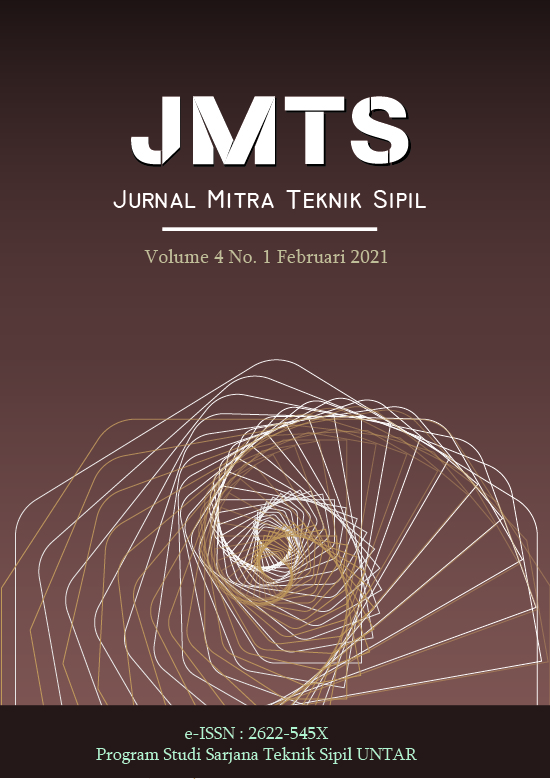Analisis Riwayat Waktu Gempa Sesar pada Sistem Fondasi Tiang
Main Article Content
Abstract
In Indonesia, many active faults that can cause earthquakes, one of them is the Palu Koro fault which extends approximately 240 km from the north (Palu City) to the south (Malili) to the Gulf of Bone. The effect of this earthquake fault caused enormous damage to infrastructure. The lower structure, namely the foundation, is part of a structure that transmits the load received from axial and lateral forces which then continues into the ground below. This foundation plays a big role in making the structure stand firm; however, pile failures still often occur in Indonesia. Because of that in this journal will be analyzing of the time history of earthquake faults in the pile foundation system. This analysis requires the assistance of a geotechnical based program. The program can process the data provided so that it produces a result that can be analyzed. The results can be in the form of internal forces, and displacement. The result of this curve we can see the effect of the earthquake fault on the foundation. From these results, it is expected to provide data to help plan structures to be built in areas prone to earthquake faults.
Abstrak
Wilayah Indonesia banyak terdapat sesar aktif yang dapat menimbulkan gempa salah satunya sesar aktif di Sulawesi adalah sesar Palu Koro yang memanjang kurang lebih 240 km dari utara (Kota Palu) ke selatan (Malili) hingga Teluk Bone. Pengaruh gempa sesar ini menimbulkan kerusakan yang sangat besar dalam infrastruktur. Struktur bawah yakni Fondasi ialah bagian dari suatu struktur yang meneruskan beban yang diterima dari gaya aksial dan lateral yang kemudian meneruskan ke dalam tanah di bawahnya. Fondasi inilah berperan besar membuat struktur tersebut dapat berdiri kukuh akan tetapi kegagalan tiang masih sering terjadi di Indonesia. Dengan demikian pada jurnal ini dilakukan analisis riwayat waktu gempa sesar pada sistem fondasi tiang. Analisis ini membutuhkan bantuan program berbasis geoteknik. Program dapat mengolah data-data yang diberikan sehingga menghasilkan suatu hasil yang dapat di analisis. Hasil tersebut dapat berupa kurva gaya dalam dan perpindahan. Hasil dari kurva ini kita dapat melihat pengaruh dari gempa sesar tersebut terhadap fondasi. Dari hasil tersebut diharapkan dapat memberikan data-data untuk membantu merencanakan bangunan struktur yang akan dibangun di wilayah yang rawan akan gempa sesar.
Article Details
References
Badan Standardisasi Nasional. Tata Cara Perencanaan Ketahanan Gempa Untuk Struktur Bangunan Gedung dan Non Gedung SNI 1726: 2019. Jakarta: Badan Standardisasi Nasional, 2019.
Broms, Bengt B. “Lateral resistance of piles in cohesionless soils.” Journal of the Soil Mechanics and Foundations Division 90.3 (1964): 123-156.
Castelli, Francesco, dan Michele Maugeri. “Simplified approach for the seismic response of a pile foundation.” Journal of Geotechnical and Geoenvironmental Engineering 135.10 (2009): 1440-1451.
Cho, Morris, Hendy Wijaya, dan Amelia Yuwono. “Analisis Kapasitas Lateral Pada Fondasi Tiang Tunggal Dan Tiang Kelompok Pada Tanah Pasir.” JMTS: Jurnal Mitra Teknik Sipil 3.4 (2020): 1105-1112.
Darendeli, M. B., dan K. H. Stokoe. “Development of a new family of normalized modulus reduction and material damping curves.” Geotechnical Engineering Report (2001).
Decourt, L. “Prediction of load settlement relationships for foundations on the basis of the SPT-T.” Ciclo de Conferencias Inter.“Leonardo Zeevaert”, UNAM, Mexico (1995): 85-104.
Hashash, Youssef MA, dan Duhee Park. “Viscous damping formulation and high frequency motion propagation in non-linear site response analysis.” Soil Dynamics and Earthquake Engineering 22.7 (2002): 611-624.
Imai, Tsuneo. “Correlation of N value with S-wave velocity and shear modulus.” (1982).
Isenhower, W. M., S. Wang, dan L. G. Vasquez. “Technical Manual for LPILE 2018, A Program for the analysis of Deep Foundations Under Lateral Loading.” (2018).
Kaharuddin, M. S., Ronald Hutagalung, dan N. Nurhamdan. “Perkembangan tektonik dan implikasinya terhadap potensi gempa dan tsunami di kawasan Pulau Sulawesi.” Proceeding The th HAGI and 40th IAGI Annual Convention and Exhibition (2011).
Lu, Yuan, dan Marios Panagiotou. “Characterization and representation of near?fault ground motions using cumulative pulse extraction with wavelet analysis.” Bulletin of the Seismological Society of America 104.1 (2014): 410-426.
Matlock, Hudson. “Correlations for design of laterally loaded piles in soft clay.” Proceedings of the Annual Offshore Technology Conference (1970): 77-94.
Pakpahan, Suliyanti, Drajat Ngadmanto, dan Masturyono. “Analisis Kegempaan di Zona Sesar Palu Koro, Sulawesi Tengah.” Lingkungan dan bencana geologi (2015): 253-264.
Reese, Lymon C., dan Robert C. Welch. “Lateral Loading of Deep Foundations in Stiff Clay.” Journal of the Geotechnical Engineering Division 101.7 (1975): 633-649.
Van der Kwaak, Ben. “Modelling of dynamic pile behavior during an earthquake using PLAXIS 2D: Embedded beam (row).” Dissertation Delft University of Technology. 2015.
Vucetic, Mladen, dan Ricardo Dobry. “Effect of soil plasticity on cyclic response.” Journal of geotechnical engineering 117.1 (1991): 89-107.


